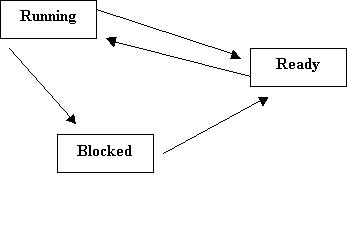
This course is run at the The University of Nottingham within the School of Computer Science & IT. The course is run by Graham Kendall (EMAIL : gxk@cs.nott.ac.uk)
A process may be in one of three states
Only one process can be running at any one time (assuming a single processor
machine). A running process is the process that is actually using the CPU at
that time.
A process that is ready is runnable but cannot get access to the CPU due to
another process using it.
A blocked process is unable to run until some external event has taken place. For example, it may be waiting for data to be retrieved from a disc.
A state transition diagram can be used to represent the various states and the
transition between those states.
 |
You can see from this that a running process can either be blocked (i.e. it
needs to wait for an external event) or it can go to a ready state (for example,
the scheduler allows another process to use the CPU).
A ready process can only move to a running state whilst a blocked process can only move to a ready state.
It should be apparent that the job of the scheduler is concerned with deciding which one of the processes in a ready state should be allowed to move to a running state (and thus use the CPU).
| Last Page | Back to Main Index | Next Page |
Last Updated : 08/01/2002